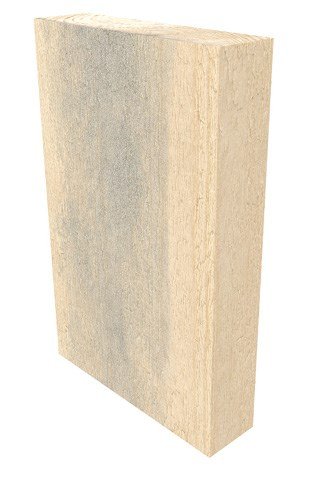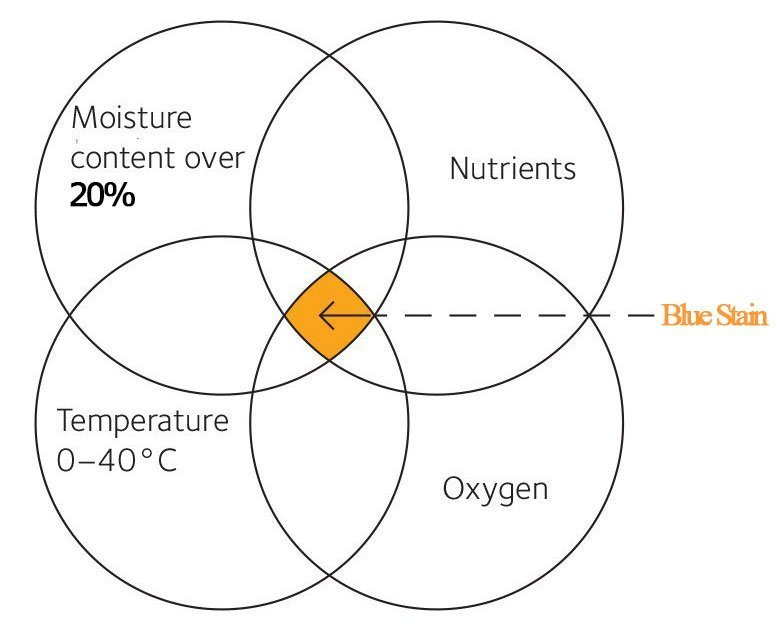As a consumer, the probability of seeing blue staining wood on a daily basis is not very large. But as a salesman in the wooden craft industry for ten years, blue stain is a situation we can’t get away or ignore. The blue stain looks like mould, but not exactly same. It makes you uncomfortable when you buy one product with it, you can not get rid it from product, broke your expectation. When we find it in production, we usually choose to abandon it, avoid the bad wood into production flow.we always told our workers to keep eyes on this defect. 
If you want to settle a problem perfect, you must find how it comes first. Most of the blues are only found in pine and oak. Our materials are mainly pine, birch, ash, and MDF, so we mainly discuss the blue stain of pine.
Blue stain is caused by fungus that grow in the interior of the wood, it rely on the Carbohydrate of wood .The multiply blue fungus hyphae secrete coloring matter, stain the cell wall, then the blue stain appears. Blue stain requires essential four conditions to micropropagation.
1) Moisture: Only when the moisture content of wood is higher than 20%, microorganisms, such as color-changing fungi can multiply and grow. Therefore, if the felled hemlock wood can be immediately dried up to a moisture content of 20% or less, and the moisture content can be kept below 20% during processing and application, the blue color can be prevented.
2) Nutrients (Nutrition): The most suitable nutrients required for various pine fungi are different, but all fungi can get the nutrients they need from pine. The carbohydrates in pine, starch and monosaccharide, are the energy needed to grow blue bacteria. In addition, trace substances (inorganic salts, ammonia compounds, etc.) in pine are also necessary for fungal growth, but the amount required is extremely small. Because the starch and monosaccharide content of rubber wood is much higher than other pine wood, rubber wood is more prone to blue color than other pine wood.
3) Air: Most fungi are good bacteria and must be grown in the presence of oxygen. However, they require a small amount of oxygen. When the oxygen content in the air reaches 1%, the fungus can grow. Therefore, it is unrealistic to use air (oxygen) to control the growth of blue bacteria.
4. Temperature Blue fungus can grow at -3 ° C, colorless at low temperatures, and the color of wood is not visible to the naked eye. When the temperature reached 8-10 ° C, it took a few weeks to see the wood turn blue.

To suppress its growth, control at least one condition is not satisfied. Therefore, we focus on the moisture of the wood, from material storage, ligand production, packaging, and warehouse.
Chinese wooded craft manufacturer generally have two source of pine wood, Northeast China (Pinus Sylvestris) and New Zealand (Pinus Radiata). The wood from China is cheaper than the one from New Zealand, but it has disadvantages in easy to produce oil, easy to crack, easy to change color, and easy to deform.
Therefore, we currently use New Zealand pine as a raw material and require ventilation and wood moisture when storing materials. When inspecting suppliers, you can also observe the possible risks by observing the way the wood is stored. It is recommended that you also test the product humidity when inspecting the product to avoid blue color changes during transportation. After all, the product should be kept in a high temperature and high humidity container for several weeks.
PS. Blue satin is not equal to mould. Mould does not only affect the appearance, but also be harmful to human’s health.
If you have any question about wooden craft, please feel free to contact us.
Sinomat Limited

Leave A Comment